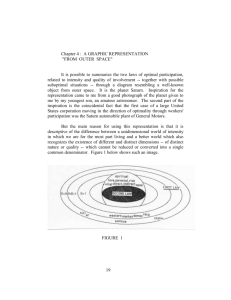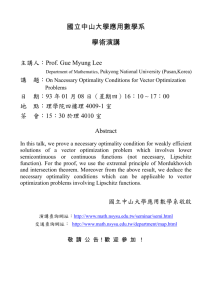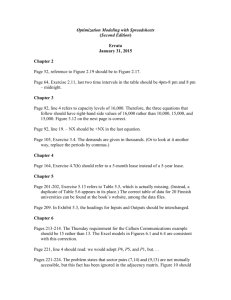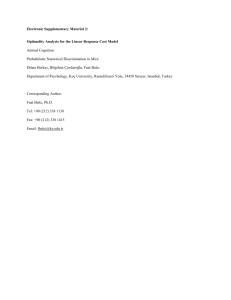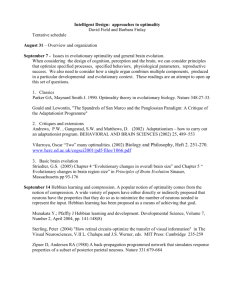L642 ADVANCED PHONOLOGICAL THEORY
advertisement
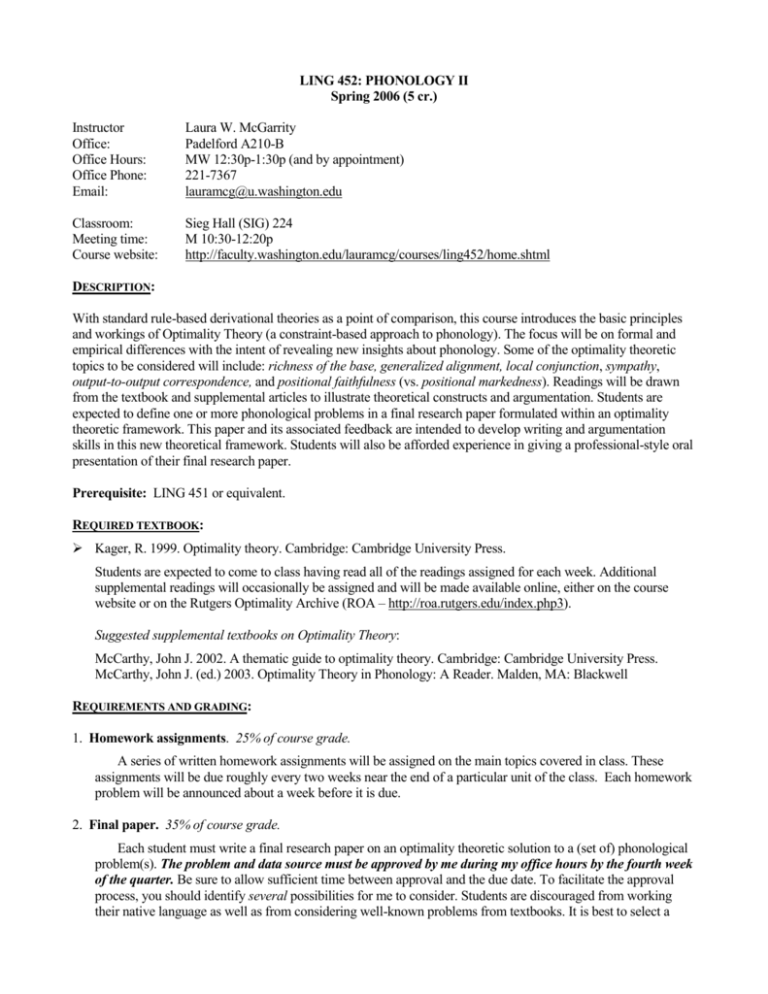
LING 452: PHONOLOGY II Spring 2006 (5 cr.) Instructor Office: Office Hours: Office Phone: Email: Laura W. McGarrity Padelford A210-B MW 12:30p-1:30p (and by appointment) 221-7367 lauramcg@u.washington.edu Classroom: Meeting time: Course website: Sieg Hall (SIG) 224 M 10:30-12:20p http://faculty.washington.edu/lauramcg/courses/ling452/home.shtml DESCRIPTION: With standard rule-based derivational theories as a point of comparison, this course introduces the basic principles and workings of Optimality Theory (a constraint-based approach to phonology). The focus will be on formal and empirical differences with the intent of revealing new insights about phonology. Some of the optimality theoretic topics to be considered will include: richness of the base, generalized alignment, local conjunction, sympathy, output-to-output correspondence, and positional faithfulness (vs. positional markedness). Readings will be drawn from the textbook and supplemental articles to illustrate theoretical constructs and argumentation. Students are expected to define one or more phonological problems in a final research paper formulated within an optimality theoretic framework. This paper and its associated feedback are intended to develop writing and argumentation skills in this new theoretical framework. Students will also be afforded experience in giving a professional-style oral presentation of their final research paper. Prerequisite: LING 451 or equivalent. REQUIRED TEXTBOOK: Kager, R. 1999. Optimality theory. Cambridge: Cambridge University Press. Students are expected to come to class having read all of the readings assigned for each week. Additional supplemental readings will occasionally be assigned and will be made available online, either on the course website or on the Rutgers Optimality Archive (ROA – http://roa.rutgers.edu/index.php3). Suggested supplemental textbooks on Optimality Theory: McCarthy, John J. 2002. A thematic guide to optimality theory. Cambridge: Cambridge University Press. McCarthy, John J. (ed.) 2003. Optimality Theory in Phonology: A Reader. Malden, MA: Blackwell REQUIREMENTS AND GRADING: 1. Homework assignments. 25% of course grade. A series of written homework assignments will be assigned on the main topics covered in class. These assignments will be due roughly every two weeks near the end of a particular unit of the class. Each homework problem will be announced about a week before it is due. 2. Final paper. 35% of course grade. Each student must write a final research paper on an optimality theoretic solution to a (set of) phonological problem(s). The problem and data source must be approved by me during my office hours by the fourth week of the quarter. Be sure to allow sufficient time between approval and the due date. To facilitate the approval process, you should identify several possibilities for me to consider. Students are discouraged from working their native language as well as from considering well-known problems from textbooks. It is best to select a 2 language for which multiple data sources are available. Some good sources can be found in old reference grammars with a companion dictionary, old dissertations, or journals specializing in descriptive issues of particular languages. A few suggested topics include stress phenomena, consonant cluster/hiatus resolution, reduplication, vowel harmony, rule interaction, opacity, or loanword phonology. Papers are due the week following your oral presentation (see the calendar below for exact due dates). It should include a complete bibliography and a 150-word abstract and will be evaluated for its conciseness, technical competence, pertinence of the data, and professional style. This paper does not call for fancy theoretical machinery. Of greater interest is your ability to define a problem and to successfully bring data to bear in addressing the problem. It is essential that all claims made in your paper be supported by critical data that are sufficient to motivate claims about underlying representations, conditions on the rules/processes, and to establish the allophonic, neutralizing, and/or assimilatory nature of the phenomena. 3. Oral presentation of final paper. 25% of course grade. Each student will present a formal conference-style (timed) presentation of their final paper on one of the following dates: May 24 or May 31 (you will be notified ahead of time on which date you will be presenting). Fifteen minutes will be allotted for each presentation with an additional 10 minutes for discussion, commentary and feedback. A handout with relevant examples, displays (data, constraints, and tableaux), and selected references should accompany the presentation. A preliminary draft of the handout must be submitted to me for feedback and corrections no later than two days prior to the scheduled presentation. A good handout should allow audience members to (re)construct the paper on their own, although text should be kept to a minimum. Headings, displays, and data sets should be numbered, labeled and organized to illustrate individual points clearly. It is expected that you practice your presentations at least once ahead of time. The presentation will be evaluated for its clarity (including organization, speaking style, usefulness of the handout), compliance with the time limit, and ability to handle questions. Helpful guidelines for giving a presentation and preparing a handout can be found on the LSA website: http://www.lsadc.org/annmeet/paperguide.html 4. Class participation. 15% of course grade. Students are expected to contribute regularly to class discussions. Completing the reading assignments in advance will facilitate those discussions. All students will also provide written peer assessments of the final oral presentations that will be evaluated for their candor and helpfulness. An anonymous summary of those assessments will be shared with the presenter. Regular attendance, while not strictly required, is crucial for productive class discussions. Whenever possible, students should notify the instructor ahead of time as a courtesy if they must miss a class for any reason. GRADING The following UW grading scale will be used (www.washington.edu/students/gencat/front/Grading_Sys.html): Percent = Grade A ≥ 95% = ____ 94 = 93 = A- 92 = 91 = ____ 90 = 89 = 4.0 3.9 3.8 3.7 3.6 3.5 3.4 B+ 88 = ___ 87 = 86 = B 85 = ___ 84 = 83 = B- 82 = 3.3 3.2 3.1 3.0 2.9 2.8 2.7 ___ C+ ___ C 81 80 79 78 77 76 75 = = = = = = = 2.6 2.5 2.4 2.3 2.2 2.1 2.0 ___ 74 73 C- 72 71 ___ 70 69 D+ 68 = = = = = = = 1.9 1.8 1.7 1.6 1.5 1.4 1.3 ___ 67 = 1.2 66 = 1.1 D 65 = 1.0 ___ 64 = .9 63 = .8 D- 62 = .7 (< .7 is a failing grade) 3 CALENDAR (**Note: It is possible that dates, topics and reading assignments may change in order to accommodate class needs. You will be notified of any changes ahead of time. K: Kager textbook, S: Supplemental) ↓ Readings: Week 1: Introduction, basic concepts____________________________________________________________ M 3/27 Syllabus, Course overview Introduction to optimality theory W 3/29 Constraints (faithfulness and markedness), Input, output candidates, violability, optimality K ch.1 (pp. 1-27) Week 2: Basic concepts, cont’d _________________________________________________________________ M 4/3 Allophonic and neutralization phenomena contextual markedness, typologies K ch.1 (pp. 27-48) W 4/5 Homogeneity of target / Heterogeneity of process, conspiracies K ch.2 Week 3: Positional faithfulness _________________________________________________________________ M 4/10 Positional faithfulness vs. contextual markedness K ch.9 (pp. 407-413), S: Lombardi (1999) W 4/12 Conflicting directionality, licensing S: Zoll (1997) Week 4: Syllable structure _____________________________________________________________________ M 4/17 Syllabification, epenthesis K ch.3 W 4/19 The syllable, cont’d; Generalized Alignment ***Topics for research paper must be approved by this date*** Week 5: Stress _______________________________________________________________________________ M 4/24 Stress parameters, Metrical constraints K ch.4 W 4/26 Stress, cont’d S: McCarthy & Prince (1993), §1-§3 Week 6: Output-to-Output correspondence ______________________________________________________ M 5/1 Reduplication K ch.5 W 5/3 Truncation, stem-affix faithfulness K ch.6 Week 7: Opacity ____________________________________________________________________________ M 5/8 Introduction to opacity effects K ch.9 (pp.372-400) W 5/10 Local conjunction Chain shifts, nonderived environment blocking S: Kirchner (1996) S: Łubowicz (1998) Week 8: Sympathy __________________________________________________________________________ M 5/15 Sympathy W 5/17 Sympathy, cont’d S: McCarthy (1999) 4 Week 9: Paper presentations __________________________________________________________________ M 5/22 Course summary and overview; course evaluations ***Draft of handout for first set of presentations due*** W 5/24 First day of student presentations (final paper due: Wednesday, 5/31 by 5:00pm) Week 10: Paper presentations _________________________________________________________________ M 5/29 MEMORIAL DAY – NO CLASSES ***Draft of handout for second set of presentations due*** W 5/31 Second day of student presentations (final paper due: Monday, June 5 by 5:00pm) First set of final papers due SUPPLEMENTAL READINGS The following supplemental readings can either be accessed through the UW library website (electronic journals), the Rutgers Optimality Archive (ROA -- http://roa.rutgers.edu/index.php3), or from the course website. Kirchner, Robert. 1996. Synchronic chain shifts in optimality theory. Linguistic Inquiry 27. 341-351. Lombardi, Linda. 1999. Positional faithfulness and voicing assimilation in optimality theory. Natural Language & Linguistic Theory 17, 267-302. Łubowicz, Anna. 1998. Derived environment effects in OT. Lingua 112. 243-280. [ROA #239]. McCarthy, John J. 1999. Sympathy and phonological opacity. Phonology, 16.331-99. [ROA #252] McCarthy, John J. and Prince, Alan. 1993. Generalized Alignment. In Yearbook of Morphology 1993, ed. by Geert Booij and Jaap van Marle, 79-154. Dordrecht: Kluwer. [ROA-7] Zoll, Cheryl. 1997. Conflicting directionality. Phonology 14. 263-286. [ROA 151].
